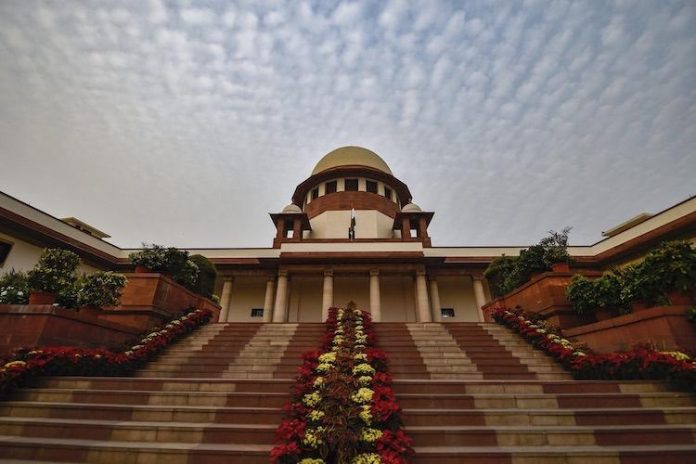This article is written by Abanti Bose, pursuing B.A.LL.B.(H) from Amity University Kolkata, India. This article explores the legal angle of Justice Vijaya Kamlesh Tahilramani’s controversial transfer and highlights the shortcomings of the collegium system associated with it.
Table of Contents
Introduction
On 28th August, 2019, Justice Vijaya Kamlesh Tahilramani, the Chief Justice of Madras High Court was abruptly transferred by the Supreme Court collegium from Madras High Court to Meghalaya High Court. Madras High Court is the fourth largest High Court in the country, whereas Meghalaya High Court is one of the newest High Courts. While it is argued that all the High Courts have similar powers under the Constitution but the controversial transfer of one of the senior-most judges from a large High Court to a small High Court is clearly seen as a demotion. This act of the collegium has raised a lot of controversies not only among the legal fraternity, but also among the citizens of India. Justice Tahilramani has discharged her duties efficiently as a Chief Justice; therefore what could be the reason behind this decision of the collegium. The collegium has only stated that this step was taken for “better administration of justice”. The Supreme Court collegium also rejected Justice V. K. Tahilramani’s request to reconsider the recommendation of her transfer to Meghalaya High Court. Thereafter, she submitted her resignation on 6th September, 2019 to the President’s office which was accepted by President Ram Nath Kovind on 21st September, 2019.
Background
Justice Vijaya Kamlesh Tahilramani was appointed as the Chief Justice of Madras High Court on 4th August, 2018. Prior to that, she served as the Acting Chief Justice of Bombay High Court (2017-2018). In September, 2019 Justice V. K. Tahilramani was transferred by the collegium supervised by the Chief Justice of India, Justice Ranjan Gogoi, and four senior-most judges; from the Madras High Court, comprising 75 judges and administered a subordinate judiciary in 32 districts including the Union Territory of Puducherry to Meghalaya High Court consisting of three judges and a subordinate judiciary in just seven districts. On the same day, the collegium had recommended that Justice A.K. Mittal, Chief Justice of Meghalaya High Court to be transferred to the Madras High Court.
The collegium denied her request for reconsideration of the transfer, thereafter she submitted her resignation in protest, which was approved by President Ram Nath Kovind.
What is the Collegium System?
The collegium system is a procedure under which the appointments and transfer of judges of the High court and Supreme court are decided by a forum consisting of the Chief Justice of India and four senior-most judges of the Supreme Court.
Evolution of the Collegium System
Three Judges Case
S P Gupta vs. Union of India and Ors., AIR 1982 SC 149
In the case S P Gupta vs. Union of India and Ors AIR 1982 SC 149; it was held that primacy of the Chief Justice of India’s recommendation to the President can be refused for “cogent reasons”. The ultimate power of appointment of judges rests with the Central Government. This case also suggested that a collegium should be formed for the appointment and transfer of judges. It was an instance where the apex court ruled against its own interests.
Supreme Court Advocates on Record Association vs. Union of India, (1993) 4 SCC 441
In Supreme Court Advocates on Record Association vs. Union of India, (1993) 4 SCC 441; the court, however, overruled the previous judgment and held that in the event of a conflict pertaining to the appointment of judges, between the President and the CJI, the opinion of the Chief Justice of India would have primacy. This case instituted the collegium system for the appointment of judges of Supreme Court and High Courts. The Chief Justice of India must consult the other members of the collegium regarding the appointment and transfer of judges, and then it should send its recommendations to the President for his consent.
Re Special Reference Case, AIR 1999 SC 1
In the third Judge’s case, the court upheld the judgment of the Second Judge’s case, and expanded the collegium to consist of the Chief Justice of India and four senior-most judges.
National Judicial Appointment Commission (NJAC)
The National Judicial Appointment Commission was constituted by the Parliament for the appointment and transfer of Judges in 2014 as a replacement of the collegium system. However, on 16th October, 2015 in the case Supreme Court Advocates-on-Record Association v Union of India, Supreme Court upheld the collegium system for appointment and transfer of judges, and struck down NJAC as unconstitutional.
The Transfer
Article 222 of the Indian Constitution permits the transfer of a judge or a Chief Justice from one High Court to another High Court. However the transfer can only be initiated by the Chief Justice of India, and he can advise such a transfer only after a resolution in the collegium.
However, the transfer of Justice Vijaya Kamlesh Tahilramani from Madras High Court comprising 75 judges and administered a subordinate judiciary in 32 districts including the Union Territory of Puducherry to Meghalaya High Court consisting three judges and a subordinate judiciary in just seven districts; has raised a lot of speculations among the citizens of India. Although it is true that all the High Courts have similar power under the Constitution but the transfer of the senior-most Judge, who also happens to be one of the two women Chief Justice’s in India, from a large High Court to one of the newest courts is clearly perceived as a demotion. The collegium also denied her request for reconsideration of the transfer without assigning any reason.
In 2017, Justice Jayant Patel was transferred from Karnataka High Court; when he was senior enough to be the Chief Justice of Allahabad High Court as a puisne judge, this led to a similar controversy.
The lack of transparency in the collegium’s decision in both the cases have highlighted the defects of the system. Members of the legal fraternity stated that such arbitrary transfer would impact the independence of the judiciary and proper functioning of the judges.
Petition filed by Advocate Prabhakaran to challenge the transfer of Justice Tahilramani
Advocate R. Prabhakaran appearing on behalf of the petitioner, filed a petition to prevent the President’s office from accepting Supreme Court collegium’s recommendations of transferring Justice V. K. Tahilramani from Madras High Court to Meghalaya High Court. He submitted before the two-judge bench presided by Justice M. Sathyanarayanan and Justice N. Seshasayee, contending that according to Article 222 of the Indian Constitution, the President needs to recommend the transfer first and the proposal cannot emanate from the collegium. The petitioner further added that the collegium should disclose the reasons of the transfer. He called out on the court to issue directions to restrain the implementation of the transfer to Meghalaya High Court.
The division bench of the court, however, dismissed the PIL petition as not maintainable, and the court also opined that the appropriate forum to express the petitioner’s concerns would be the Supreme Court or the Parliament.
Controversies raised
The transfer of the senior-most Chief Justice from Madras High Court comprising 75 judges to Meghalaya High Court consisting three judges, has raised a lot of controversies. The Secretary-General of the Supreme Court stated “the recommendations for transfer were made for cogent reasons after complying with the procedure in the interest of better administration of justice.” There had been a lot of speculation behind the transfer, a reporter in The Print expressed that senior judges at Madras High Court wanted to elevate two lawyers as judges but since the lawyers did not meet the required age limit, Justice Tahilramani turned down the proposition.
In a piece published in The Week, former Supreme Court Judge Justice Markandey Katju opined that there were other conjectures behind the transfer. He said that Justice Tahilramani was “hardly working” in Madras High Court, and she was not present during the post-lunch sessions. He further added, she never pronounced judgements, and only gave interim orders. Another source said her abrupt dissolution of a bench hearing idol-theft cases that was set up by Justice Indira Banerjee, when she was the Chief Justice of Madras High Court, could be one of the many reasons. Also, it has been pointed out that Justice Tahilramani upholding the conviction and imprisonment of the accused in Bilkis Bano case associated with the Gujarat communal riots could be a reason of this unforeseen transfer, although she was made Chief Justice much after this judgement which weakens the attempt to link this cause to her transfer.
Criticisms
It is a valid point that all the High Courts have similar power under the Constitution, but the inexplicable transfer of Justice Tahilramani has made us question the collegium system. Not disclosing the reasons for transfer have highlighted the faults of the collegium system such as opaqueness and scope for personal opinions. The insufficiency of information available due to this transfer has made us question the credibility of the collegium system. It is essential to understand that a transfer of judge or Chief Justice of a High Court can only be ordered for public interest and administration of justice; it cannot be a punishment in disguise.
The lack of transparency and unaccountability of the collegium system has been the main grounds for criticism. Although it is true that the judiciary needs to be independent in order to properly deliver justice but the unfettered power of the collegium might lead to abuse of power. And the arbitrary transfer of senior judges without adequate reasoning and justification would impact the independence of the judiciary and proper functioning of the judges.
Conclusion
The transfer of Justice Tahilramani without disclosing the reasons have emphasized the inefficacy and opaqueness of the collegium system once again. The collegium system has come under a lot of scrutiny in the last few years pertaining to the abrupt and unanticipated transfer and elevation of judges. Also, the transfer of one of the two women Chief Justice’s in the country shows how much the Apex court needs to work to uphold its administrative side regarding women. The inexplicable transfer of the highest-ranked woman judge in the country will only harm the credibility of the collegium system. The Supreme Court collegium must publish the reasons for her transfer from a larger court to a relatively small court. This system of transferring and elevating judges should be transparent and should disclose the reasons for elevating and transferring judges to the public to avoid controversies and to make the system more plausible. The independence of the judiciary forms the basic foundation of democracy but independence without transparency and accountability might lead to abuse of power and will be detrimental for the administration of justice.
References
- https://www.barandbench.com/news/madras-hc-junks-pil-challenging-transfer-chief-justice-vk-tahilramani
- https://www.thenewsminute.com/article/justice-tahilramani-transferred-inefficiency-writes-justice-katju-sparks-debate-108813
LawSikho has created a telegram group for exchanging legal knowledge, referrals and various opportunities. You can click on this link and join:
 Serato DJ Crack 2025Serato DJ PRO Crack
Serato DJ Crack 2025Serato DJ PRO Crack











 Allow notifications
Allow notifications



